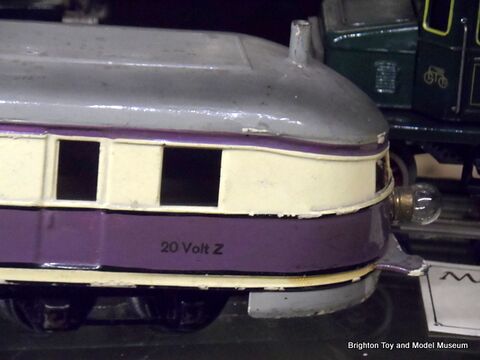Flying Hamburger train (Marklin TW12970)
| Star Exhibit |
|---|
Flying Hamburger train (Marklin TW12970) |
 |
| location: |
| Arch Three , Area 32 Märklin Model Railways (display) |
Original loco details:
| [[]] | No.12970 | _-_-_ |
| Originally built: | 1933 | |
[[Category:]]
A streamlined, articulated gauge 0 20 Volt electric "Flying Hamburger" train, made by Märklin in 1937, catalogue number TW 12970). These models were produced between 1932 and 1938.
Details
Marklin produced three main versions of the violet-and-cream Hamburger, a clockwork version without lights (TW 970), a gauge 0 electric version with a single headlight and red tail-light (TW 12970), and a larger Gauge 1 electric version with a pair of headlights and a pair of red tail-lights (TW 12971) – the museum's version is the electric gauge 0 version with the single electric light front and back.
Märklin also produced a red-and-cream diesel-electric train model based on their Hamburger design, but in red-and-cream, and with an additional central section.
The "Flying Hamburger" train
The diesel-electric Flying Hamburger (a.k.a. Fliegender Hamburger, or Hamburg Flier) -- officially the Baureihe SVT, and then the Deutsche Bundesbahn Baureihe VT -- came into service in 1933 as the basis of a high-speed inter-city rail link between Hamburg and Berlin, which was then reckoned to be the world's fastest scheduled train service.
For a while, the Hamburger was one of the most advanced and influential trains on the planet, with locomotive designers from all around the world visiting Germany to ride the new streamlined train, before going back home and experimenting with streamlining themselves. The fact that the Hamburger design worked and worked well, and was a high-profile success, was arguably the trigger for the rash of streamlined steam locomotive designs that then appeared in the UK, mainland Europe and the US in the early to mid 1930s.
Configuration
The "Hamburger" consisted of a "pushme-pullyou" coupling of two strongly streamlined units, each of which had a rounded driver's cab at one end, followed by the engine section and an integrated carriage. A pair of these units butted together by their flat "carriage" ends produced a small, streamlined, double-ended, high-speed train that could shuttle passengers the 178 miles between the two city stations in fractionally over two and a quarter hours, and could then pick up a new batch of passengers and head straight back the other way.
See also:
- Henschel/Wegman_streamlined_train another German streamlined train for the 1930's.
- Autorail Panoramique - another double-ended two-unit train.
References
- Christian Väterlein and Botho G. Wagner, Märklin Eisenbahnen (Battenberg Verlag Augsburg, 1996), p. 164, ISBN 389441233X
External links
video







